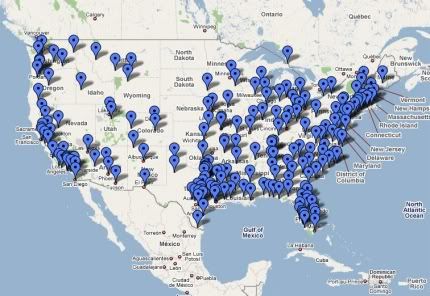

Location, location, location
For those of us who have blogged (and those who have written magazine articles, and talked on Fox News), it was exhilarating stuff. A weight has been lifted. Millions of Americans are saying publicly what a hermetic few argued only a handful of years ago. The cork has popped.
If there's anything to worry about, it's probably not co-option by the Republican Establishment. Many tea partyers have made it clear that they see the drawbacks of Pubby collaboration, except in hand-picked cases. This fight isn't taking place on the standard political chessboard.
Making allowances for the obvious connection with tax deadline day, it was still a little disturbing to see such obsession with taxes. Since ancient Rome, people have hated taxes. Politicians understand that, and have ways to anesthetize the pain -- "We need to raise taxes to reduce the deficit," "Soak the rich," and so on. Making the tea party protests essentially an anti-tax movement is playing a mug's game.
Taxes are a symptom, not the problem.
Raising cain about taxes will, at best, hold down increases while the political class takes the soft option, trying to postpone the reckoning.
Politicians act like they have lost any comprehension of how an economy should work. They operate on the Marxist belief system that every problem can be solved by voting government (i.e., taxpayer) money for it; that wealth can be redistributed while kneecapping the enterprise that creates the wealth they want to distribute.
Or maybe our rulers understand the damage they are doing. They just won't look at it. "I've got mine, Jack."
For a quick tour of our looming financial blow-up, I turn you over to tour guide Karl Denninger. If you don't like numbers, you don't need to focus on them so much as follow the argument.
" ... You can't fix debt intoxication with another bottle of whiskey," he says.
We added more Federal debt than had been accumulated in 217 years in just a little over THREE years - from 2007 to the third month 2010.The ugly is that this debt load (currently $12.8 trillion, more or less) presents interest expense. If the Fed Funds Target was to reach just five percent, and every bit of the Treasury debt was to be refinanced into overnight obligations at that same 5%, the interest expense alone of the current debt would be $640 billion a year.
If the Treasury was to have to pay a roughly 6% average coupon (reasonably aggressive with a 5% Fed Funds Target) the interest expense would be $768 billion annually.
To put this in perspective that is an amount roughly equivalent to that spent on defense, and is higher than Social Security, Medicare, or all other "mandatory" program spending combined.
It would consume nearly all of Social Security and Medicare tax receipts ($891 billion) or the personal income tax ($915 billion) (ed. All 2009 federal budget numbers)
Denninger may be an alarmist, but only false alarms are bad.



1 comment:
Financial crises, when they get bad enough, can have a malign and lasting effect on the social fabric. The effects of the German hyperinflation of 1922 are vividly described by Sebastian Haffner, who was there, in this excerpt.
I don't think we're at much danger of Weimar-level hyperinflation: I do think we're at serious danger of long-term structural unemployment/underemployment, combined with ongoing inflation at a moderate but still painful level, low productivity increases, and declining standards of living.
Post a Comment